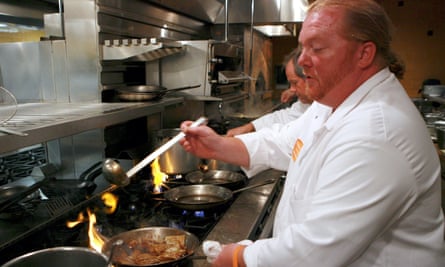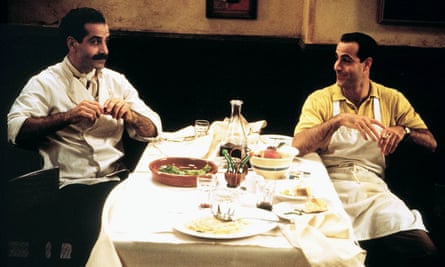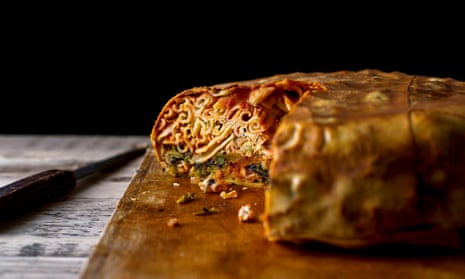There’s this new restaurant you gotta try – no one knows about it yet. It’s called Paradise, and it’s Italian, real Italian, near the water in a little east coast port town a couple hours’ drive from here. The dining room is spare and simple, with a lovely curved wooden bar up front, an antique espresso machine, and charming paintings on the wall donated by some local artist, I think in exchange for dinner.
Yeah, a real mom-and-pop spot, except “mom” and “pop” are two brothers from Italy who don’t always get along. But the food? They say the seafood risotto’s the equal of anything in Venice, and on special occasions they’ll make timpano, this drum-size cake of pasta, meatballs, hard-boiled eggs, sauce, and, well, magic. Unbelievable. You free Saturday?
One hitch: Paradise doesn’t exist.
Or rather, Paradise exists, but only in Big Night, the great food movie starring Isabella Rossellini, Tony Shalhoub, and Stanley Tucci. Premiered at the Sundance Film Festival 20 years ago – on January 24, 1996 – Big Night focuses on the volatile relationship between two immigrant restaurateurs, the uncompromising chef Primo (Shalhoub) and his younger sibling, Secondo (Tucci), who runs the dining room and is trying desperately to keep the business afloat.
That’s a particular challenge because Big Night is set in the late 1950s, when Italian-restaurant customers demanded spaghetti and meatballs, not delicate Venetian rice dishes. Over the course of a few days, the brothers cook, bicker, court women (Rossellini, Minnie Driver and Alison Janney), and host a wild, hours-long feast for the musician Louis Prima, in an attempt to drum up the good press they need to stay alive. It is not revealing too much, I hope, to say that this big night does not go entirely according to plan.

In the year after its premiere, Big Night got great reviews (96% fresh, according to Rotten Tomatoes), won multiple awards for its screenplay (written by Tucci and his cousin Joseph Tropiano) and its co-directors (Tucci again, with Campbell Scott), and earned nearly $12m against its estimated $4.1m budget, according to IMDb.
More important than that, Big Night helped kick off a revolution in American food culture. It wasn’t just that restaurants were changing, with “authenticity” the new watchword. How we looked at and thought about food shifted, in both minor (the band Cibo Matto released its first album, featuring food-mad tunes like Know Your Chicken and White Pepper Ice Cream) and major ways.
In 1996, the Food Network gave shows to Mario Batali, Bobby Flay, and Emeril Lagasse, quickly establishing its dominance over the nascent world of food porn. While it’s impossible to say if Big Night is fundamentally responsible for these innovations, it did encapsulate them – and in some ways predicted the future of the business.
“It was a cultural milestone for me,” said Batali, who says he’s watched it roughly 40 times since it came out, most recently over Christmas vacation. At the time of the movie’s release, Batali was making a name for himself as the chef at Pó (where Tucci was a regular), shooting Molto Mario, the Food Network show on which he demonstrated his encyclopedic knowledge of Italian regional cooking – and proving, as Big Night did as well, that there was more to the cuisine than red sauce.
“The idea that the Italians had broken the meal into distinct antipasto, pasta, and farinaceous products, followed by a main course, was still news to Americans back in the 1990s,” Batali said – this despite the efforts of restaurateurs like Lidia Bastianich, who’d spent years gradually introducing notions of regionality, authenticity, and meal structure into her New York restaurants. The movie, however, “served that home”, as Batali put it, in a way no single restaurant could. (It didn’t hurt, he added, “that Isabella Rossellini was so hot”.)
In one of the film’s most famous scenes, Primo flips out when a customer, having ordered risotto, asks for a side order of spaghetti and meatballs. “Who are these people in America?” the mustachioed chef fumes, calling the customer a “bitch”, a “criminal”, a “philistine”. “How can she want? They both are starch. Maybe I should make mashed potato for another side.” Secondo, meanwhile, pleads with his brother: “Make the pasta. Make it. Make it. Make the pasta!”
This concept that “the kitchen was, versus the dining room, often at intellectual and physical odds” was a new one as well, Batali said. American diners “were always used to the idea that the front-of-the-house guy ran the whole store, and then they started realizing that the cook had an opinion”. And maybe not only had an opinion but was, like Primo, an artist, a heretofore-unheralded visionary. No matter how much you might sympathize with Secondo, when Primo rhapsodizes, “To eat good food is to be close to God,” you are virtually required by movie logic to side with the chef in all matters culinary.

That widespread epiphany clearly benefited chefs like Batali, who became such superstars in the decade and a half following the film’s release that it’s almost hard for diners under 40 to imagine a food world dominated by maître d’s.
For a long time, and surely in part thanks to Big Night, the Primos have been prevailing, not just in the form of authentic cuisine but with lengthy tasting menus and an overall sense that diners should submit themselves to a chef’s vision, rather than requiring a kitchen to live up to their own tastes and expectations.
Recently, though, that dynamic has seemed to shift, with Secondo’s philosophy gaining ground among diners and restaurateurs alike.
“This is kind of a bigger argument that everybody is talking about right now, right? They’re sick of tasting menus and chefs dictating how you eat,” said Sara Jenkins, the chef at Porsena and Porchetta, who grew up in Rome and Tuscany and has been cooking in the US for more than 30 years. “I think most successful restaurateurs ultimately wind up becoming more accommodating, not less, you know?”
That’s true at Del Posto, the serene palace of Italian fine dining that is one of just five restaurants to be given four stars by the New York Times. Executive chef Mark Ladner, who’s been cooking Italian since 1998, said he thinks of himself as a Primo – “although I respect both sides of the conversation.”
Despite the sophistication of the restaurant, which serves dishes such as slow-roasted Abruzzese lamb and a pasta with tuna belly and porcini, “we still have people who expect spaghetti and meatballs”, Ladner said. “And after years of fighting against it, I realized I like spaghetti and meatballs as much as the next guy, and there’s no reason not to sort of play with this tongue-in-cheek interpretation of some of these Italian American classics, because they’re classics for a reason.”
Other restaurateurs, however, are natural-born Secondos. Take Mario Carbone, who in 2013 opened Carbone, a throwback Italian-American restaurant in the West Village that looks like a high-end version of Paradise, complete with tuxedoed waiters and Louis Prima on the sound system. Carbone’s a total Secondo, his partner Rich Torrisi a Primo.
“Rich is the one who wants to know who ordered risotto while they want spaghetti,” Carbone said. “I’m like, ‘Can you just fucking give it to them, please? Just give them the spaghetti.’ That is my relationship, me and my other business partner. He would totally agree.”
Regardless of which philosophy currently holds sway, perhaps the movie’s signal achievement was to bequeath the restaurant world this set of archetypes and references against which everyone from cooks and busboys to waiters and owners can compare themselves. Am I a Primo or a Secondo? Is this the kind of customer who’d order risotto with spaghetti? How can we put on a “big night” of our own – and maybe get some much-needed media attention? Numerous chefs told me about reenacting scenes from the movie in their kitchens, particularly the risotto-spaghetti battle and another in which Primo sarcastically offers to put a hot dog on the menu. So powerful is the set of references that both Del Posto and Carbone have used clips from the movie to train staff (including at Carbone’s Hong Kong outpost).
Did Big Night, I wondered, actually invent the phrase “big night”? Possibly.
Originally, Stanley Tucci said by phone from London, the movie was to be called The Paradise. But, he said, “this thing kept coming up, this phrase – hey, the big night, the big night –and we just thought why don’t we call it Big Night?”
The name stuck, and so did the idea. The big night, two decades after Big Night, is what restaurateurs and diners alike seem to want. The San Francisco company that owns the restaurants Marlowe, the Cavalier, S&R Lounge, and Park Tavern calls itself Big Night restaurant group. And Carbone wants all meals to feel like the movie’s climactic feast. “I give oranges and nuts at the end of the meal here,” Carbone said, “because I want it to be a total shitshow. I want wine stains, I want orange peels, I want nut cracks, I want crap everywhere. When someone leaves, it should look like a bomb went off at the table.”

Nothing epitomizes the big night more than timpano, the epic baked pasta dish that is the movie’s droolworthy centerpiece. Existing all over Italy in different versions, it often requires days to prepare its constituent elements: sauce, meatballs, eggs, noodles, and more. In recent years, as large-format dishes have become trendy again, timpano has begun to appear at New York restaurants.
On Sunday evenings at Sessanta, in Soho’s The Sixty Hotel, chef Jordan Frosolone makes a Sicilian rendition, dubbed Timballo di Zanghi ($42, serves 3 to 5), sheathed in eggplant shingles rather than pasta, with an interior of ring-like anneletti and pork ragù. Similarly, Del Posto’s version ($100, serves four) is wrapped not in noodles but in focaccia dough, uses escarole leaves to keep the interior moist, and is scooped out to serve, rather than dramatically sliced, as in the movie.
“If it was to form a slice,” said Ladner, “it would have to be so dry and bound with so much egg that it doesn’t actually eat very well.”
For that matter, Tucci said the movie’s own timpano was awful: “All the food was spat out by all of the actors. The audience walked out of the theater starving, and the actors walked away from the set sick.”
Which brings up an odd aspect of this food film. Apart from the big-night feast (tricolor risottos, a whole roast pig, that timpano), there’s not really that much food in the film, and very few of the overhead, close-up, detail-obsessed shots that define present-day food porn. But what imagery is there has a realism to it, and its accessibility only deepens its appeal.
“You didn’t want to make the food look too kind of beautiful. It just had to look appetizing, not beautiful,” Tucci said, adding that he’d make “significant changes” if he were shooting today. “Sometimes I think it looks a little too shiny, a little too posed. The timpano doesn’t really look the way it’s supposed to look. But that said, that’s just me being difficult, as usual.”
Indeed, to watch Big Night today is to realize how vastly the food world has changed, and how speedily. In the late 1950s, a small-town mom-and-pop restaurant specializing in authentic Italian food seem ed like a clear recipe for failure. Even in the mid-1990s, it was a risky proposition. In 2016, however, it’s brilliant. Who among us now is unwilling to travel for a bite of something incredible we’ve only seen on Instagram? In Camden, Maine, for example, Long Grain serves serious Thai food, using local seafood, mushrooms, and sometimes rabbit. In upstate New York, restaurants such as Fish & Game have turned the town of Hudson into a major culinary destination.
If Primo and Secondo’s Paradise were to open today in, say, Keyport, New Jersey (where Big Night was shot), “beating the Yelpers to it would be a major coup”, Batali said. “Having it truly be an unknown is kind of the dream of every gastronomic person that follows the world around. They want to be the first one to find this traditional, authentic, magnificently perfectly run place that looks like it was art-directed by Stan Tucci.”
Tucci, he said, was “an oracle”. And I’m inclined to agree: Big Night feels as real, and as relevant, as ever. But did it bring today’s food world into existence? Or merely predict how we eat now, with food at the center of nearly every relationship? And does it even matter, as long as we’re eating well?
“If you want to give me credit, I’ll take it,” Tucci said. “All of us who made that movie, we’ll take the credit.”
To horribly misquote another epic Italian American movie: take the credit, Stanley, but leave us the timpano.

Comments (…)
Sign in or create your Guardian account to join the discussion